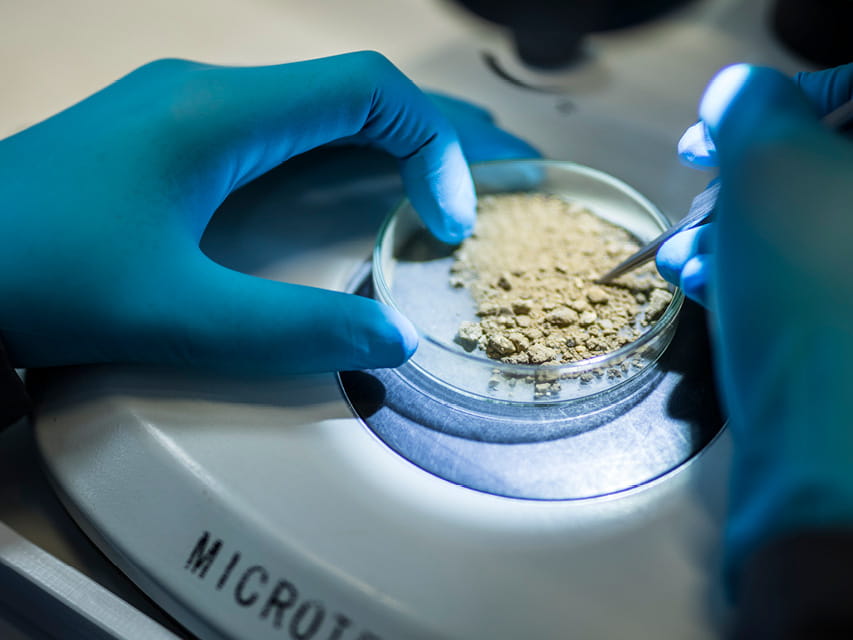Poly and Perfluoroalkyl Substances (PFAS): Answering your most Frequently Asked Questions
Per- and polyfluoroalkyl substances, collectively known as PFAS, are a group of man-made chemicals that include PFOA, PFOS, and GenX.
Due to their ability to repel water and oil, PFAS are widely used as non-stick and stain-resistant agents, as surfactants, and in polymer manufacture. In recent years concerns have increased about potential health risks due to their persistence in the environment.
Element’s contaminant experts can help you deepen your knowledge about PFAS substances and existing regulations by answering some common questions on the topic.
What are PFAS substances?
Poly- and perfluoroalkyl substances (PFAS) are a large group of synthetic organofluorine chemicals that have been widely used in industry and manufacturing since the 1940s. There are >5,000 known compounds.
PFAS have at least one fully fluorinated methyl (–CF3) or methylene (–CF2–) group, with the carbon-fluorine bonds (C–F) imparting high thermal stability and resistance to degradation, making them useful in a wide variety of products. However, they are persistent and bio-accumulative, meaning they do not break down in the environment, and can readily migrate to the air, water, soil, and food, potentially causing harmful effects on human health.
The Interstate Technology & Regulatory Council has prepared a PFAS Technical and Regulatory Guidance Document, updated June 2022 (https://pfas-1.itrcweb.org) which provides a PFAS family tree (Figure 2-3), reproduced below. This captures some of the wide variety of PFAS compounds including two primary classes: polymers and nonpolymers. Each class may contain many subclasses, groups, and subgroups, some of which are shown in the figure.
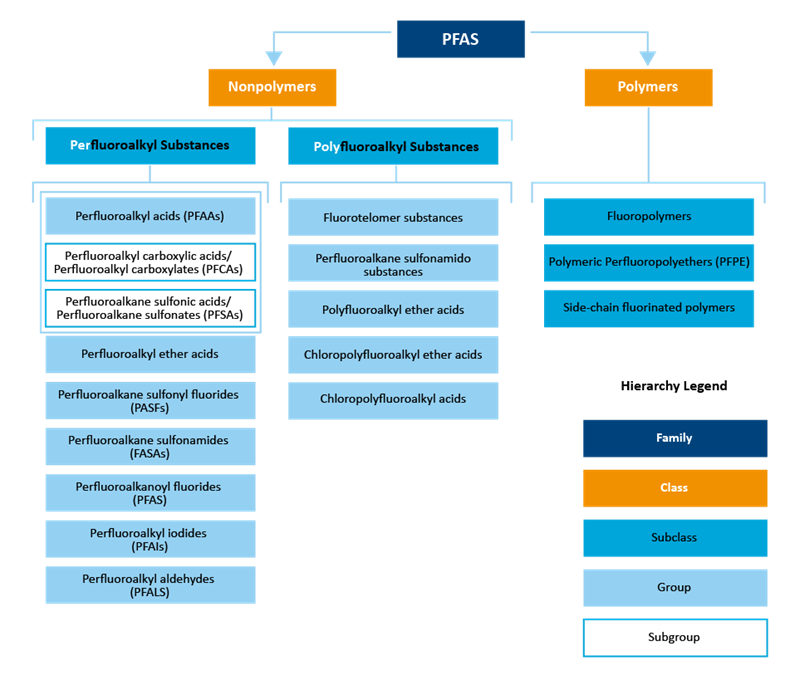
Some PFAS - such as some polyfluorinated alkyl substances - can partially degrade or transform in the environment. The end degradation products are typically perfluoroalkylated acids (PFAAs), most commonly perfluoroalkylated sulfonic acids (PFSAs) and perfluoroalkylated carboxylic acids (PFCAs) which are highly resistant to further degradation. PFAAs can persist in the environment for decades or longer and are sometimes referred to as ‘forever chemicals’.
What are PFAS used for?
PFAS have seen widespread global use since the 1950s in a diverse range of applications, including surface coatings for non-stick cookware, carpets, soft furnishings, paper, leather, and metal and performance chemicals, like cleaning agents and firefighting foams. Point sources of contamination may include sites with current or historical uses comprising:
- Petrochemical facilities
- Textile and leather manufacturing
- Paper and board manufacturing
- Metal plating/etching
- Sites that have a history of using firefighting foams such as airports, military bases, large industrial facilities
- Landfill sites
- Wastewater treatment facilities
Are PFAS substances regulated?
Regulatory focus on PFAS is steadily increasing to protect against perceived risks to human health and the environment. PFOS is already listed in the Stockholm POP convention, and the UN has recommended a global ban on PFOS and PFOA. Their use is already highly restricted within the EU, as well as in other countries. Many countries have adopted drinking water guidelines ranging from 0.01µg/l up to 1µg/l and the EU has set a sub ppt Environmental Quality Standard of 0.00065µg/l for PFOS (to be achieved by 2027). Guideline values in the ppb ranges are also being established for soils by many other countries.
The EU includes 20 PFAS substances within Annex III of EU Drinking Water Directive 2020/2184 and is consulting on prescribing 24 compounds. The England & Wales Drinking Water Inspectorate (DWI) specify 47 PFAS substances to be monitored.
How does Element test for PFAS compounds?
Preparation of samples prior to analysis is in accordance with sample matrix type or required limits of detection. For waters, a portion of ‘as received’ water sample is centrifuged, and an aliquot of the supernatant liquid is taken and mixed with methanol in a 50:50 ratio for analysis by direct injection.
For soils, a portion of ‘as received’ soil is extracted with basic methanol via sonification and end-over-end extraction. A ‘clean-up’ stage is then performed on the resultant extract using SPE to produce a 50:50 MeOH: H2O mix for analysis.
Analysis utilizes a Liquid Chromatography system coupled with tandem mass spectrometers. It is applicable for aqueous samples or solid samples extractable in water-miscible organic solvent such as Methanol or Acetonitrile.
A known volume of prepared sample is injected into the LC system for analysis by reverse phase LC and triple quadrupole mass spectrometry. Identification of PFAS is carried out in dMRM, with majority of compounds having two monitored transitions, the most specific of which is used for quantification and the other used to confirm the peak identification.
Internal Standards are employed and are added at the same concentration to the calibration and the samples once extracted. These correct for potential injection differences as well as sample matrix effect but will not be linked to the extraction process efficiency. Instead, surrogate standards are employed to provide information as to the efficiency of the extraction process.
To prevent contamination by the LC system, a delay column is employed. This is placed after the pump and will delay any potential PFAS leaching from the mobile phase or the system. The PFAS is still present but elutes later and is therefore separated from the PFAS associated with the samples.
What is TOP Assay?
Thousands of polyfluorinated compounds (PFAA precursors) are used in industrial and consumer products and there is concern that these may overtime biotransform to PFAAs. Total Oxidisable Precursors (TOP) Assay is a procedure developed to estimate the effect of these precursors on future PFAAs concentration.
The received samples are treated with potassium persulphate (60mM) and sodium hydroxide (0.125M) before heating at 85C for 6 hours. Once cool the samples are neutralised with HCl prior to analysis by LCMSMS for PFAS suite.
The received water samples are also analysed untreated by LCMSMS for PFAS suite alongside the treated samples. A mass-labelled precursor (C13 6:2 FTS) is added to monitor efficiency of the oxidation. The difference between the treated and untreated concentrations is the concentration of the non-discrete PFAA precursors.
If we want to test for PFAS, how do we go about it?
To learn more about PFAS testing or to begin the testing process, please contact us today.
Find related Resources
Get white papers, updates and event invites
Subscribe to content updates
Learn more
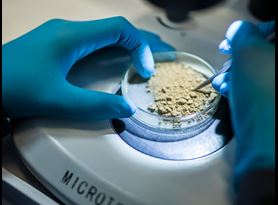
PFAS Testing
Find out how PFOS and PFOA testing with Element's experienced technicians can ensure that you remain compliant with regulatory standards protecting human health and the environment.
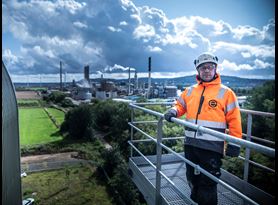
Environmental Compliance & Safety
Element’s industry-leading environmental compliance and safety services help our customers to demonstrate the highest possible standards of environmental compliance and socially responsible performance.
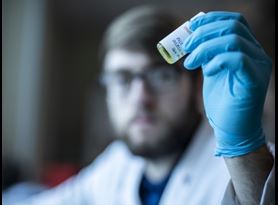
Wastewater Testing & Analysis
Element is your trusted partner for specialist water distribution services and wastewater analysis, providing quality and accurate results that help you meet regulatory requirements.
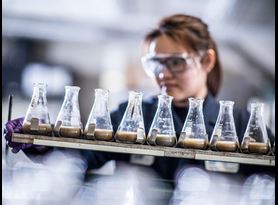
Soil Testing Services
Element’s soil testing and analysis services include the analysis of soils, sediments, wastes and leachates to determine the level of nutrients and identify any contamination
